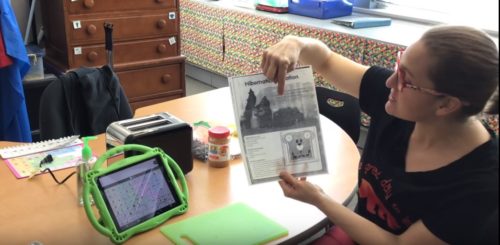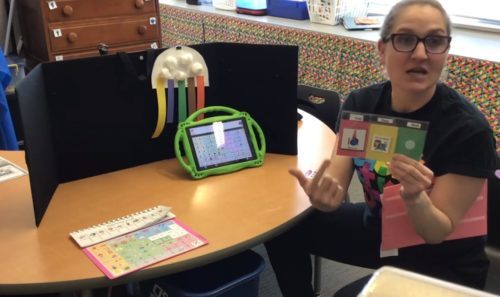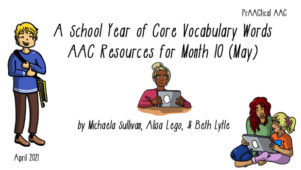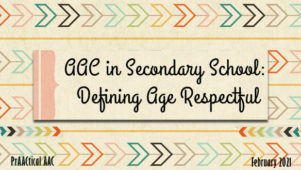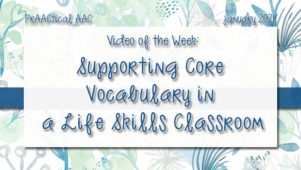PrAACtical Perspectives: Normalizing AAC

How do we help people with complex communication needs become fluent in using AAC throughout the day? There are lots of factors to consider in working toward that goal, and our guest author for today encourages us to think of one of them. Special educator Amy Campbell believes that one thing we can do to support AAC learners is to normalize the use of AAC tools and strategies. Amy is the 2020 Washington State Teacher of the Year and has been a Special Education teacher for 12 years. Over that time, she has focused on how to increase student independence and improve the inclusion of students with disabilities into general education settings and the greater community. Like many of you, she has now pivoted to supporting her students from a distance.
Don’t miss the videos Amy creates for her students and their families so learning can continue from afar.
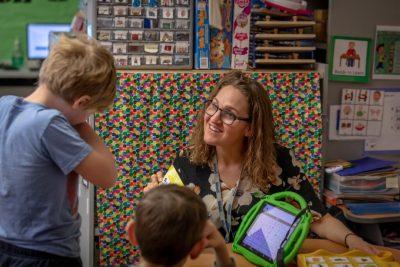
My experiences collaborating with my colleagues and supporting students have taught me that we must provide authentic access to language for students who are nonverbal. We must also provide strategies and accommodations that will support nonverbal students so that they can engage with all curricula, and with their peers.
What does this mean for me? I need to teach using AAC to increase student skills and to normalize the use of AAC. I need to teach our users that their voices are valid in all spaces. I need to show the world that equity and access require their active participation in teaching and learning with AAC.
At school, all our nonverbal students have access to AAC devices all the time. My staff and I MODEL the words we are using on a variety of devices (which increases receptive understanding of the message and models words to be expressed later). I create opportunities for peers to play games using the AAC to increase their skills and understanding. I give space for my nonverbal students to try to communicate if they wish. My students do receive pull out speech services from our SLP. But also, she and I collaborate to improve my confidence in modeling on devices, and that has taught me that I can have a huge impact on improving language skills and generalization for my students.
What does this mean for you? I am sad about COVID-19, but it was the catalyst I needed to finally make some homespun videos to showcase for my families, other teachers, and the WORLD how I am working to model language for emergent AAC users. YES, I want everyone to watch me try to make messages on devices, and now I want them to see YOU using the devices with your children, and, more importantly, I want them to see YOU making messages on their devices. The world and our children need to know: AAC is NORMAL. It takes time, but it gives everyone a chance to communicate, to be heard. Just as we should attempt to translate content for non-English speakers, we have the opportunity to translate our lessons and lives into the language of our AAC users.
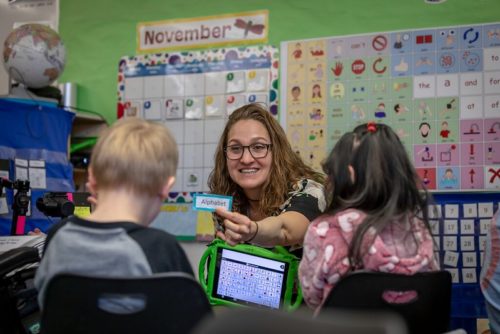
My hope in sharing today is to inspire you to start modeling on your child’s AAC device all around your home and, as we move out of social isolation, you will have built the confidence to model with the device all over the community. Here are some tips for parents attempting to implement instruction at home. These ideas will work for students who have disabilities or are AAC users, but they will also work for all children. Cheers to you for moving learning into your homes.
- Make sure the AAC is always available to the user. (Core Board counts! My staff carry core boards everywhere to model language on). Model on the device. Even if you only find one or two words in each sentence; it is fine to target just a few words each week as you learn. Provide exciting opportunities to use the device in different ways (comment, request and reject items and activities). Provide a ton of time for students to attempt to make a message, but never force communication.
-
- Watch Mrs. Campbell makes a Bear Snack to see me model using AAC the way I do during instruction
2. Make learning visual. Modeling on AAC will improve students’ receptive understanding of experiences, tasks, and activities. Also pairing visuals with actions or items can provide additional reinforcement of visual language. Providing simple visual schedules, “first work, then choice” (and use of choice boards), as well as visual steps in routines and tasks, will increase children’s ability to complete tasks without support and increase their pride and sense of self.
-
-
- Watch “Mrs. Campbell demonstrates making a cloud with a rainbow” to see how to utilize visuals, and integrate the use of timers and sensory strategies into your instruction.
-
In my classroom, we are all emerging AAC users. We stumble together, and we give each other grace as we look for words together. We celebrate first words, new words, bad words, and we showcase for the world that access to content requires access to language. We must all take the opportunity to model AAC in the broader world, not as professional users but as emerging learners.
Join with me! Let’s show the world our AAC!
Filed under: Featured Posts, PrAACtical Thinking
Tagged With: AAC implementation, classroom, learn-at-home, school
This post was written by Carole Zangari
